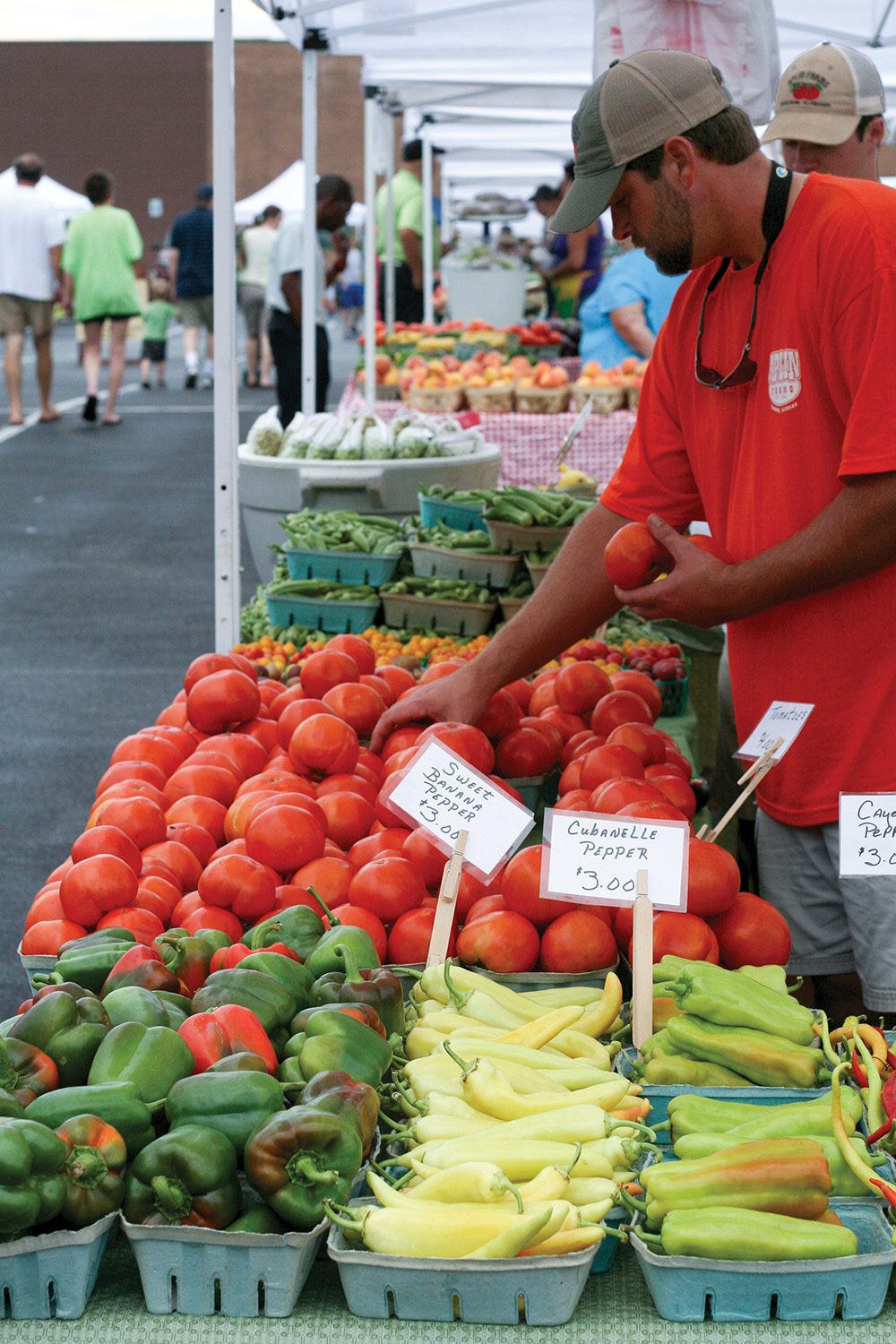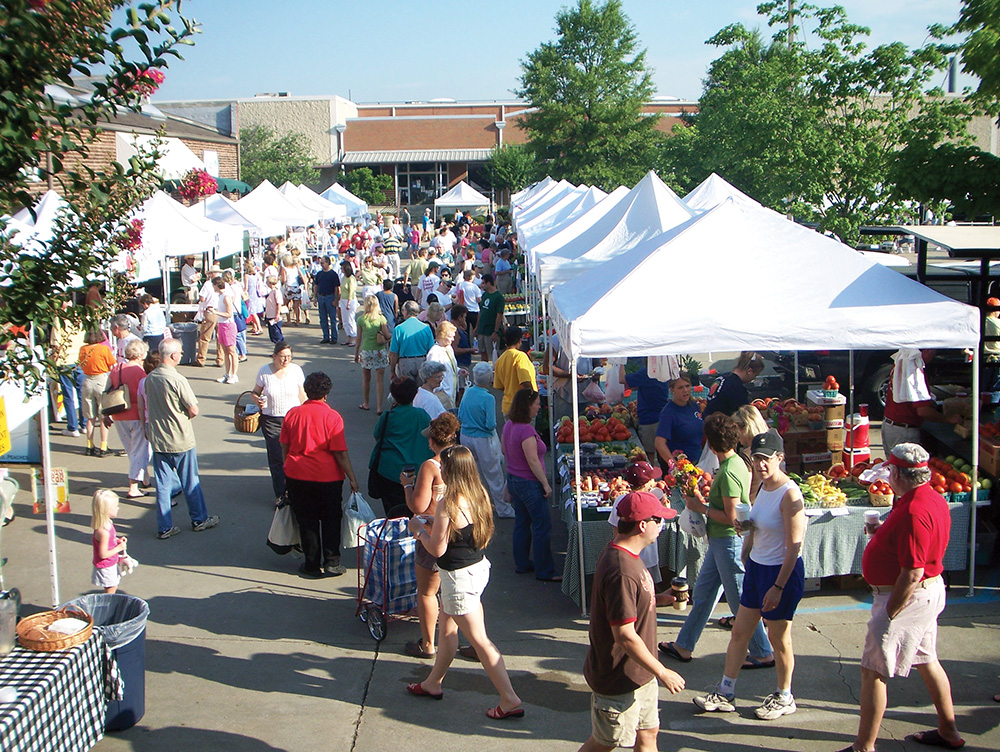
By Jennifer Kornegay / All photos courtesy of the Alabama Farmers Market Authority
For many of us, the convenience of the closest grocery story is just too much to resist. Even in Alabama – where agriculture is still a flourishing industry, making a variety of fresh produce available – for decades, we’ve chosen to buy and consume fruits and veggies trucked in from other states, including places on the other side of the country.
But that’s been steadily changing over the last 20 years, according to Don Wambles, director of the Alabama Farmers Market Authority. “In 1999, we had 17 farmers markets in the state, with about 235 farmers involved,” he says. “This year, when all are open, we will be in the 170 to 175 range of markets, with almost 1,000 farmers selling in those markets.”
That means more folks are purchasing local food and by doing so, making a huge positive impact on the economy, racking up between $25-$30 million in sales annually. “That’s a lot of watermelons,” Wambles says.
And these figures only include farmers markets, not farm and produce stands.
Wambles attributes this huge uptick to two factors. One is the Senior Farmers Market Nutrition Program, a federal assistance plan that provides vouchers to elderly in need that allow them to access products from farmers markets. “That really took off in 2004, and because of it, we had markets open in areas previously without one,” Wambles says. “We’ve got the fourth largest program of this type in the country, dollar-wise.”
The second has been a surge of interest in what we’re eating and where it came from among Alabamians of all ages and walks of life. “While the senior program was growing, so was awareness of the importance of local food systems. People started asking questions,” Wambles says. “They wanted to put a face on their food, and there’s no better way to do that than to shop a farmers market.”
It seems our foods’ origin stories are gaining a value that’s equal to their taste. The growing number of customers created enough demand to open even more new markets and to keep existing ones booming.
The program for seniors planted the necessary seeds, but the tide has turned in recent years. “Now, 85 to 90 percent of our sales are from everyday people,” Wambles says. “The seniors with vouchers represent a very small percentage of the business done at markets.”
Taking it to the tents

Today, farmers market numbers in our state total 10 times what they were in the late 1990s, and many in this newer crop of markets are built on a different model, one that the Farmers Market Authority introduced and encouraged after Wambles traveled to California to examine that state’s successful markets.
“I noticed that out of more than 300, only two were held in permanent structures. The others were tent markets,” he says. He learned that for most markets, buying property in a good location and constructing a building was cost prohibitive.
But, if they found a parking lot or park that would let them set up temporary tents a day or two a week, they could afford it. And then they had money left over to spend on advertising and promoting the market. “I thought that made great sense,” Wambles says.
He came home, and the Authority worked to get The Market at Pepper Place going in 2000; it’s primarily a tent market held in a formerly industrial section of Birmingham in paved lots around the old Dr. Pepper syrup plant. It was a hit.
The offerings from area farmers drew crowds, but the sea of bright white tents and the feeling it was an “event” also created an engaging, festive atmosphere that added much to the market’s appeal.
“I don’t know if that is as easily replicated in a permanent structure,” Wambles says. He explained why. “If you ride by a permanent market structure seven days a week, and people are only there selling two to three days a week, it is mostly empty, so you stop noticing it,” he says. “With tents, they stand out; they come and go, so you don’t get visually accustomed to it. The change draws your eye, and when it’s up and running, seeing all the people milling around, chatting, that draws you in.”
Another plus: Tent markets can be sized to fit the needs and preferences of almost any community anywhere. “They’re very flexible and scalable,” Wambles says.
There are several permanent markets in Alabama, and they represent some of the state’s most enduring – spots like Montgomery’s Curb Market and the oldest running market, the Alabama Farmer’s Market in Birmingham, founded in 1921 and operating in its current location since 1956.
Supporting local people
But no matter how they’re set up, it’s obvious that the popularity of farmers markets has been and still is on the rise. That’s great news for market newbies like Eric Bern. The chef turned farmer left the heat of commercial kitchens for sunny days in his China Grove, Ala., fields in 2013 and founded his Bearded Pickle Company in 2016.
He sells most of his fresh produce to restaurants, but turns some of it into lip-puckering pickles, fiery hot sauce, spicy-sweet strawberry jelly, caramelized onion-fig jam with bacon and more. He sells these treats at The Shoppes at EastChase Farmers Market in Montgomery every summer and fall, where he sees thousands of people each week.
He offered his take on why they keep coming. “All of the produce at any farmers market is just so, so fresh,” he says. “It was probably picked yesterday or even that very morning. And most products there, like mine, are small-batch and homemade with a lot of care and love.”
And while the flavorful foods for sale are certainly major draws, the allure doesn’t stop there. “You’re supporting local people and keeping money in your community,” Bern says. “You get to meet the farmer. You can ask questions about his growing methods, get tips for your home garden, and sometimes, you can sample before you buy.”
Wambles believes the overall experience attracts many market shoppers. “You can build a relationship with a food provider where you learn their challenges,” he says. “That gives you a true appreciation of the labor that goes into feeding you. It’s social too. You chat with other folks. It’s fun for kids, so a great family activity and a way to get children interested in eating healthy and trying new things.”
The sense of community is as rewarding for many of the farmers as it is the shoppers. “I love talking to the customers,” Bern says. “I get to meet new people every time, but I also love repeat clients telling me how great my product is, or even offering some constructive criticism.”
He enjoys time with his fellow farmers too. “I like hearing their stories, how they got started,” he said. “We can swap advice.”
The multiple, immediate benefits of thriving local farmers markets for both farmers and consumers are clear, but they are also crucial components of a sustainable local food system. If we don’t support our farmers now, who’ll grow our food – and how will they grow it – in the future?
Farmers markets or produce stands? What’s the difference?
When Don Wambles, director of Alabama’s Farmers Market Authority, talks about farmers markets, he’s using this definition: A public place where several farmers gather several times a week to sell their goods.
Farm stands (a spot where one farmer sells only his produce) and produce stands (permanent spots that sell a variety of produce and are usually open year round) are different.
There are approximately 250 farm stands in the state, a number that has grown alongside the growth in farmers markets (and is not included in Wambles’ market numbers).
And produce stands are scattered all over too, places like Durbin Farms in Clanton and SweetCreek in Pike Road. While they’re not under the “official” farmers market umbrella, they pursue many of the same goals and offer many of the same advantages.
“We love those places, too,” Wambles says. “And we try to help them connect with local farmers so they can always have fresh, seasonal, local produce to sell.”
Find your farmers market
Visit fma.alabama.gov to find a full list of farmers markets across the state listed by county. And remember: Many Alabama farmers markets are hawking far more than fruits and veggies. Look for homemade jellies, relishes and baked goods, raw honey, organic meats, handmade soaps and more.





